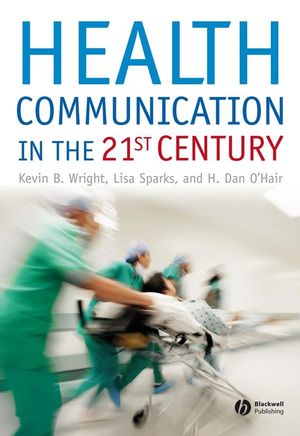|
Textbook
Health Communication in the 21st CenturyISBN: 978-1-4051-5594-6
Paperback
344 pages
November 2007, ©2007, Wiley-Blackwell
 This title is out-of-print and not currently available for purchase from this site.
|
1. Overview of Communication and Health.
Arguments for the Need to Study Health Communication.
Defining Health Communication.
A Brief History of Health Communication Research.
Current Challenges to the Healthcare System and the Role of Health Communication Research.
Overview of the Book.
Summary.
Part II: Interpersonal Perspectives:.
2. Provider–Patient Communication.
Provider and Patient Views of Health and Healthcare.
Provider Perspective.
Patient Perspective.
Provider–Patient Interaction.
Improving Provider–Patient Communication.
Outcomes of Provider–Patient Communication.
Communication and Medical Malpractice Lawsuits.
Summary.
3. Caregiving and Communication.
Caregiving.
Hospice and Palliative Care.
Attitudes Towards Death and Dying.
Summary.
Part III: Social, Cultural, and Organizational Contexts:.
4. Social Support and Health.
Types and Functions of Social Support.
Models of Social Support and Health.
Perceptions of Support Providers.
Strong Tie Versus Weak Tie Support Networks.
The Role of Communication in the Social Support Process.
Support Groups for People with Health Concerns.
Communication Processes within Support Groups.
Summary.
5. Culture and Diversity Issues in Healthcare.
Patient Diversity.
Cultural Differences in Concepts of Health and Medicine.
Recognizing Cultural Diversity in Health Beliefs.
Alternative Medicine.
Spirituality, Culture, and Health.
Social Implications of Illness.
Changing Social Perceptions of Health Issues through Communication.
Provider Diversity.
Summary.
6. Communication and Healthcare Organizations.
Healthcare Organizations as Systems.
Types of Healthcare Organizations.
Communication within Healthcare Organizations.
Healthcare Organization Culture.
Influences on Healthcare Organization Communication.
Provider Stress, Conflict, and Support within Healthcare Organizations.
Summary.
Part IV: Influences of Technologies and Media:.
7. New Technologies and Health Communication.
Health Information on the Internet.
New Technologies and Patient–Patient Communication.
New Technologies and Provider–Provider Communication.
New Technologies and Provider–Patient Communication.
New Technologies and Health Campaigns.
Summary.
8. Mass Communication and Health.
Two Perspectives of Media Influence.
Needs Fulfilled by the Mass Media Concerning Health.
Media Usage, Health Portrayals, and Health Behaviors.
Health News Stories in the Media.
Summary.
Part V: Risk, Campaigns, Communities, and Teams:.
9. Risk and Crisis Communication.
Defining Risk Communication.
Global and Large-Scale Health Threats.
At-Risk Communities within the United States.
Communication Strategies for Addressing Health Risks.
Community-Based Health Initiatives for At-Risk or Marginalized Populations.
Risk Communication Strategies at the Provider–Patient Level.
Summary.
10. Health Campaigns and Community Health Initiatives.
Campaign Goals.
Theoretical Approaches to Health Campaigns.
The Process of Conducting a Health Campaign.
Formative Campaign Evaluation.
Summary.
11. Interdisciplinary Healthcare Teams.
Diversity of Healthcare Professionals.
Importance of Interdisciplinary Teams.
Continuum of Healthcare Teams.
Model of Synergistic Healthcare Teams.
Summary.
Part VI: Contexts, Challenges, and Choices:.
12. Emerging Health Communication Contexts and Challenges.
Health Literacy.
Breaking Bad News.
Health Communication and Older Adults.
Summary.
Index



